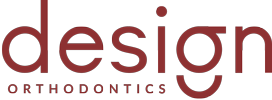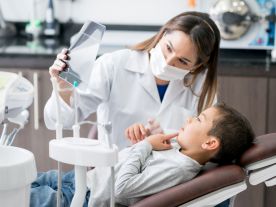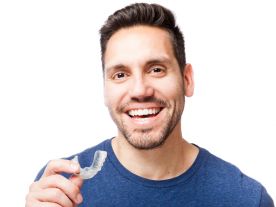
1) GROWTH MODIFICATION (FUNCTIONAL) APPLIANCES
These plates are used to address size discrepancies between the upper and lower jaws. Cases where the lower jaw is too short often result in protrusive upper teeth, commonly called ‘buck teeth’.
If the lower jaw is too far forward then an ‘underbite’ may be evident.
Both of theses situations may be treated with a functional appliance. A common solution for a shorter lower jaw is the Twin Block appliance, while a Facemask in conjunction with a Quad Helix or RME appliance may be used to treat cases where the lower jaw is protrusive relative to the upper jaw.
(PLEASE LEAVE TWO SMALL SPACES TO ADD PHOTOS)
2) UPPER REMOVABLE APPLIANCES (PLATES)
Plates may be used to undertake relatively simple tooth movements, for example correcting a single front tooth that may be in a crossbite relationship.
Your orthodontist may also suggest using a URA to correct a ‘deep bite’. This is where the vertical overlap of the front teeth is too great, and the lower front teeth hit the gum tissue behind the upper front teeth. If this was to be left untreated it can cause permanent damage to the gum tissue in the palate, or excessive wear or chipping to the incisor teeth.
As the name suggests, these plates may be removed by the patient. However, for maximum benefit they should be worn almost full time.
The only times to take your URA out are to eat, to clean your teeth, or if you are doing active sports.
When not in your mouth, remember to keep your URA in the case supplied. You don’t want to lose it!
(PLEASE LEAVE 1 SMALL SPACE TO ADD PHOTO)
3) ANTI HABIT APPLIANCES
Habits such as thumb or finger sucking can have serious consequences on the future development of teeth and supporting bone structure. Often as a result of these habits from a young age the front teeth will not bite together, and this may cause difficulties in eating certain foods. Long term, however the severity can mean permanent deformation of the bone.
For this reason we strongly recommend preventative measures to stop these types of habit as early as possible.
Design Orthodontics recommends a modified Quad Helix appliance, which is highly successful in intercepting and stopping this habit.
(PLEASE LEAVE 1 SMALL SPACE TO ADD PHOTO)
4) EXPANSION APPLIANCES
These appliances are usually used to treat narrow upper jaws, also referred to as maxillary constriction. A narrow upper jaw often results in a crossbite on the back teeth and can be the cause of facial asymmetries.
At Design Orthodontics we use two types of plates, the Quad Helix and the RME (Rapid Maxillary Expander).
(PLEASE LEAVE 2 SMALL SPACES TO ADD PHOTOS)
5) SPACE MAINTAINER APPLIANCES
If the back baby teeth are lost too early, then the remaining teeth tend to move forward into the space. This may result in overcrowding as the adult teeth start to develop and try to erupt into the mouth. This can mean the need for extraction of permanent teeth later.
In order to prevent drifting at the onset, a space maintainer appliance can be fitted following the early loss of the baby teeth.
(PLEASE LEAVE 1 SMALL SPACE TO ADD PHOTO)






